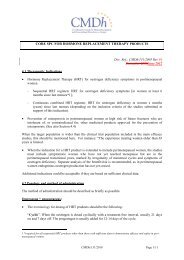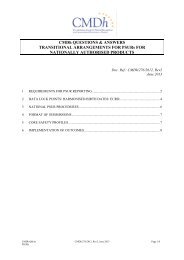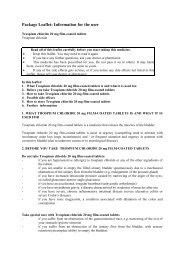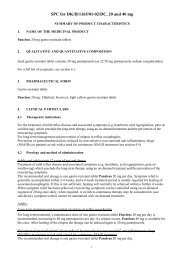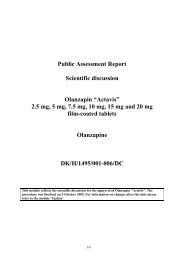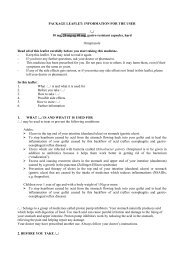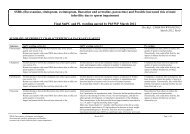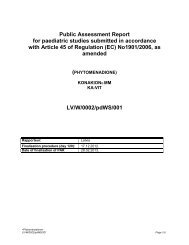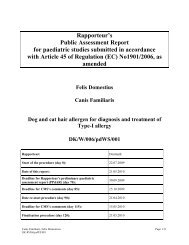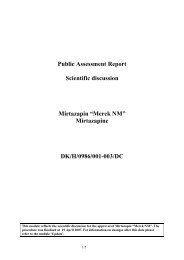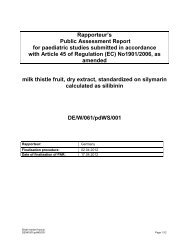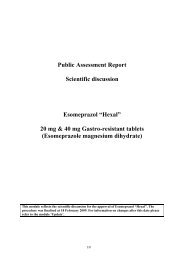Public Assessment Report for paediatric studies submitted in ...
Public Assessment Report for paediatric studies submitted in ...
Public Assessment Report for paediatric studies submitted in ...
You also want an ePaper? Increase the reach of your titles
YUMPU automatically turns print PDFs into web optimized ePapers that Google loves.
subjects <strong>in</strong> the VENTOLIN HFA 180mcg group), and s<strong>in</strong>us arrhythmia (1 subject <strong>in</strong> the VENTOLIN<br />
90mcg group only). Other adverse events were reported <strong>in</strong> one or less subjects per treatment group.<br />
Symptoms of adrenergic stimulation<br />
At all on-treatment assessments, all subjects had no tremor present.<br />
The mean change from basel<strong>in</strong>e <strong>in</strong> the heart rates <strong>for</strong> the week 4 pre and post dose were<br />
consistent <strong>in</strong> terms of a drop <strong>in</strong> all three treatment groups (i.e. range of -1.6 to - 5.4 <strong>for</strong> the week 4 predose<br />
and -2.9 to 3.0 <strong>for</strong> the week 4 post dose group) except <strong>for</strong> the post-dose VENTOLIN 180mcg group<br />
where the heart rate <strong>in</strong>creased by 3 beats/m<strong>in</strong>ute.<br />
FSII(R) questionnaire<br />
Functional Status II (R) was assessed by the parent/guardian-<strong>for</strong> the study site adm<strong>in</strong>istered<br />
FSII(R) questionnaire <strong>for</strong> each subjects. Mean scores were similar across the treatment groups at Basel<strong>in</strong>e<br />
and at Endpo<strong>in</strong>t except <strong>for</strong> the sleep well and unusually irritable scores at basel<strong>in</strong>e that were slightly lower<br />
<strong>in</strong> the placebo group.<br />
Cl<strong>in</strong>ical laboratory assessment<br />
No AEs of hypokalemia were reported.<br />
Blood glucose values rema<strong>in</strong>ed fairly consistent across the treatment groups over the course of<br />
the study.<br />
No AEs of hyperglycemia were reported. Six subjects, (2 <strong>in</strong> the placebo group and 3 and 1<br />
subject <strong>in</strong> the VENTOLIN 90mcg and VENTOLIN 180mcg groups respectively) had laboratory errors at<br />
the study term<strong>in</strong>ation visit either due to hemolysis, failed blood draw attempts and/or parent refusal to<br />
blood draw<br />
ECG monitor<strong>in</strong>g<br />
At Week 4, mean changes from basel<strong>in</strong>e <strong>in</strong> heart rate, and QT <strong>in</strong>terval were small. Mean<br />
changes from basel<strong>in</strong>e <strong>in</strong> heart rates <strong>for</strong> the subjects <strong>in</strong> the VENTOLIN HFA 90 mcg group were slightly<br />
higher (-5.4 to -2.9 bpm) when compared to VENTOLIN HFA 180mcg (-1.6 to 3.0 bpm) or placebo (-4.5<br />
to -2.0 bpm). No subject had a QT or QTc (Fridericia’s <strong>for</strong>mula) <strong>in</strong>terval >460msec.<br />
Vital s<strong>in</strong>gs<br />
Mean values <strong>for</strong> systolic and diastolic blood pressure at Week 4 were comparable to those<br />
observed at basel<strong>in</strong>e except <strong>for</strong> systolic pressure <strong>in</strong> the VENTOLIN 90 mcg group which was slightly<br />
higher (5.5mmHg) at Week 4. Mean changes from basel<strong>in</strong>e were very small, rang<strong>in</strong>g from 0.4 to<br />
5.5mmHg <strong>for</strong> systolic blood pressure and -0.9 to 3.4mmHg <strong>for</strong> diastolic blood pressure.<br />
Mean values <strong>for</strong> heart rate, body temperature, and respiratory rate at Week 4 were also<br />
comparable to those observed at basel<strong>in</strong>e.<br />
Physical exam<strong>in</strong>ations<br />
At the end of the study, there was a higher <strong>in</strong>cidence of unfavorable changes <strong>in</strong> the VENTOLIN<br />
HFA 180 mcg treatment group (7 subjects) compared to the VENTOLIN HFA 90mcg (2 subjects) and<br />
placebo (3 subjects) treatment group. These changes were primarily ENT (ear, nose and throat), 5 subjects<br />
<strong>in</strong> the VENTOLIN HFA 180 mcg group vs. 2 and 1 subject <strong>in</strong> the placebo and VENTOLIN HFA 90mcg<br />
groups respectively. A slightly higher <strong>in</strong>cidence of ENT, hair and sk<strong>in</strong>, and respiratory changes were<br />
noted <strong>in</strong> the placebo and VENTOLIN HFA 180 mcg treatment groups (2 and 5 subjects respectively)<br />
compared to the placebo group (1 and 2 subjects, respectively) and the VENTOLIN 90mcg group (0<br />
subjects <strong>in</strong> each body system). An unfavourable change <strong>in</strong> the urogenital body system was noted <strong>in</strong> the<br />
VENTOLIN HFA 90 mcg group (1 subject) only.<br />
Assessor's comment:<br />
The results of the primary, secondary and other efficacy parameters showed similar improvements from<br />
basel<strong>in</strong>e <strong>in</strong> all treatment groups over 4 weeks of treatment.<br />
Salbutamol F<strong>in</strong>al <strong>Public</strong> <strong>Assessment</strong> <strong>Report</strong><br />
RO/W/0001/pdWS/001<br />
Page 30/76



